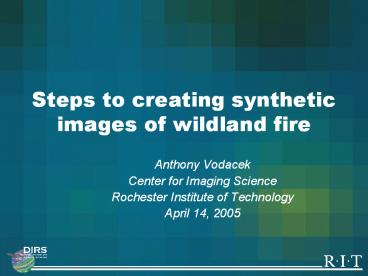Steps to creating synthetic images of wildland fire - PowerPoint PPT Presentation
1 / 16
Title:
Steps to creating synthetic images of wildland fire
Description:
3D Flame structure is not explicitly in the NCAR model nor is it in the fire ... In general, the higher the buoyancy, the relatively warmer the atmosphere ... – PowerPoint PPT presentation
Number of Views:44
Avg rating:3.0/5.0
Title: Steps to creating synthetic images of wildland fire
1
Steps to creating synthetic images of wildland
fire
- Anthony Vodacek
- Center for Imaging Science
- Rochester Institute of Technology
- April 14, 2005
2
Flame Visualization
- 3D Flame structure is not explicitly in the NCAR
model nor is it in the fire propagation code - Does it matter if we create realistic flame
structure and smoke? - Needed for creating realistic synthetic images
from model outputs for comparison to real images
of a fire scene - Needed for better visualization for the fire
manager - How do we create realistic flame structure?
- Temperature data
- Real spectral data and blackbody spectral model
- Attenuation coefficient through flame
- 3D modeling of an emissive transparent object (a
gas)
3
Albany NY pinebush thermocouple at surface of
mineral soil
Temperature data
4
Real Flame spectra and blackbody model
Infrared Systems spectrometer continuously
variable filter
ASD spectrometer
5
Flame thickness and radiance
Series of measurements on experimental fires at
the Fire Science Lab
6
Flame thickness and radiance
- Optically thin result, relative radiance was
linear with temperature - Attenuation coefficient is very small
7
- Digital Imaging and Remote Sensing Image
Generation Model (DIRSIG) - A first principles ray tracing code that is
spectral (visible to thermal) - Facetized solid reflective surfaces
- Transmissive objects (tree leaves, gas plumes)
- Thermal history
- MODTRAN atmospheric model
- Sensor model
8
Voxels in DIRSIG
- A voxel is a 3D pixel
- Transmission through voxels (an attenuation
coefficient) - Voxel temperature (800 C)
9
Voxel emission -- for now
3x
2x
1x
- The voxel is an emitting source to the sensor
- We can do this now, see example
- New measurements at Missoula needed to
determine spectral attenuation
10
Voxel emission the future
3x
2x
1x
- The voxel as a secondary source
- New coding in DIRSIG is required. Ready by
August?
11
Buoyancy output from the NCAR model In general,
the higher the buoyancy, the relatively warmer
the atmosphere Display buoyancy as grayscale
Lower threshold, larger region, looks like smoke
Higher threshold, smaller region, looks like flame
Original data from Janice Coen, NCAR
12
- DIRSIG scene
- 3D voxels
- 1073K blackbody
- 10 m flames
- RGB (lines)
- Grass on ground
- No reflection from
- the fire to the
- ground
fire
grass
13
WASP image, Albany, NY Prescribed burn 1.35 ?m
DIRSIG 2.2 ?m
14
(No Transcript)
15
(No Transcript)
16
(No Transcript)































